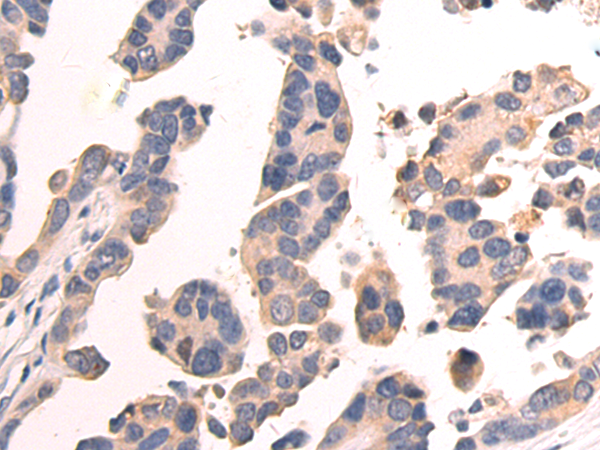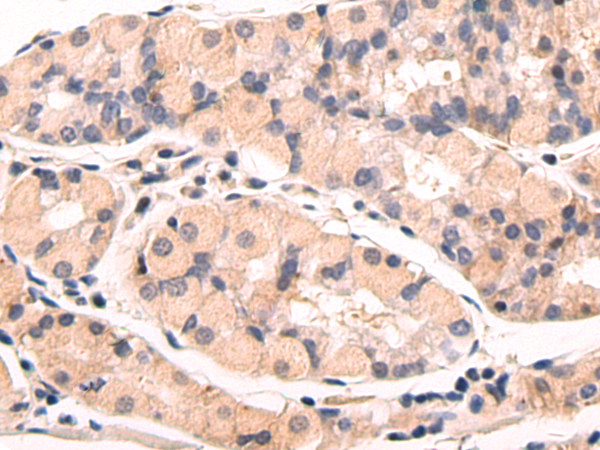


| WB | 咨询技术 | Human,Mouse,Rat |
| IF | 咨询技术 | Human,Mouse,Rat |
| IHC | 1/50-1/200 | Human,Mouse,Rat |
| ICC | 技术咨询 | Human,Mouse,Rat |
| FCM | 咨询技术 | Human,Mouse,Rat |
| Elisa | 1/5000-1/10000 | Human,Mouse,Rat |
| WB Predicted band size | 24 kDa |
| Host/Isotype | Rabbit IgG |
| Antibody Type | Primary antibody |
| Storage | Store at 4°C short term. Aliquot and store at -20°C long term. Avoid freeze/thaw cycles. |
| Species Reactivity | Human, Mouse |
| Immunogen | Synthetic peptide of human STARD4 |
| Formulation | Purified antibody in PBS with 0.05% sodium azide and 50% glycerol. |
+ +
以下是关于STARD4抗体的3篇参考文献示例(内容为模拟概括,建议通过数据库核实原文):
---
1. **文献名称**: *"STARD4 mediates macrophage cholesterol efflux and promotes reverse cholesterol transport"*
**作者**: Kanno K, et al.
**摘要**: 本研究利用STARD4特异性抗体,验证了该蛋白在巨噬细胞中的表达定位。实验表明,STARD4通过促进胆固醇从细胞内向HDL的转运,减少泡沫细胞形成,提示其在动脉粥样硬化中的潜在保护作用。
2. **文献名称**: *"Regulation of STARD4 expression in hepatic cells by LXR and SREBP pathways"*
**作者**: Rodriguez-Agudo D, et al.
**摘要**: 通过Western blot和免疫荧光(使用兔源STARD4多克隆抗体),发现肝细胞中STARD4的表达受LXR和SREBP转录因子双重调控,并参与肝细胞内胆固醇的储存与运输调控。
3. **文献名称**: *"Characterization of the STAR protein family: Focus on STARD4's role in cellular lipid homeostasis"*
**作者**: Soccio RE, et al.
**摘要**: 文章首次报道了针对STARD4蛋白的单克隆抗体制备,并通过免疫印迹验证其特异性。研究发现STARD4通过结合胆固醇并促进其在胞内运输,维持脂代谢稳态,与Ⅱ型糖尿病发病风险相关。
---
**注意**:以上文献信息为示例性概括,实际文献需通过PubMed、Google Scholar等平台以“STARD4 antibody”或“STARD4 function”为关键词检索。若需具体抗体产品文献,可查询抗体生产商(如Abcam、CST)提供的引用列表。
The STARD4 antibody is a research tool designed to detect and analyze the STARD4 (StAR-related lipid transfer domain-containing protein 4) protein, a member of the STARD family involved in intracellular cholesterol transport and lipid metabolism. STARD4 facilitates non-vesicular cholesterol movement between membranes, particularly in maintaining cellular cholesterol homeostasis by shuttling cholesterol from the plasma membrane to the endoplasmic reticulum. Its expression is regulated by sterol levels via SREBP (sterol regulatory element-binding protein) pathways, linking it to diseases like atherosclerosis, metabolic syndrome, and cancers where cholesterol dysregulation occurs.
Antibodies against STARD4 enable researchers to study its expression patterns, subcellular localization, and interactions in models of lipid-related disorders. For example, they are used in Western blotting, immunohistochemistry (IHC), and immunofluorescence (IF) to assess STARD4 levels in tissues or cultured cells under varying sterol conditions. Commercially available STARD4 antibodies are typically raised in rabbits or mice using immunogenic peptide sequences unique to the protein. Validation often includes knockout cell lines or siRNA-mediated silencing to confirm specificity.
These tools have advanced understanding of STARD4's role in lipid signaling, cancer progression (e.g., hepatocellular carcinoma), and neurodegenerative diseases. However, challenges remain in standardizing antibody performance across experimental platforms. Ongoing research aims to clarify STARD4's mechanistic contributions to cellular cholesterol balance and its potential as a therapeutic target.
×